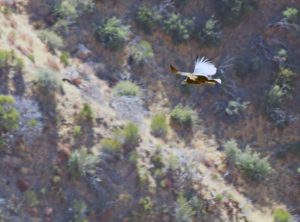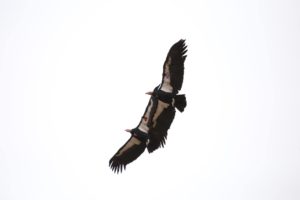Santa Barbara County, Calif.— For the first time in more than three decades, an endangered California condor chick has successfully fledged from a cliff-side nest in Santa Barbara County. Last month, the young bird took its first short flight after six months of being raised by its parents in the northern Santa Barbara backcountry of Los Padres National Forest.
The chick, known as condor 933, hatched in late April and was raised by a six-year-old female condor and a 38-year-old male condor, popularly known as AC-4. This new chick represents a milestone in the condor recovery program as the first second-generation wild fledgling in Southern California. The chick is also AC-4’s first offspring to successfully take flight from its nest in the wild.
AC-4 fledged from the Santa Barbara backcountry in 1980. For more than 30 years, AC-4 served a pivotal role in recovering California condors from near extinction. He was among 22 California condors — the last remaining on Earth — captured by biologists in the 1980s to create a captive breeding program. AC-4 was returned to the wild in 2015. While in captivity, he sired 30 chicks that were later released into the wild as part of the U.S. Fish and Wildlife Service-led California Condor Recovery Program.
2018 was a record-breaking nesting season for California condors in southern California. Scientists recorded 12 nests in 2018 — the highest number of nests across the broadest range ever documented in the area.
The fledging marks the first time in decades that condors have successfully nested in Santa Barbara County. Historically, condors were often seen soaring over the Santa Barbara backcountry, as depicted on Chumash pictographs on the walls of caves. They occasionally nested in cliffs on the southern slope of the Santa Ynez Mountains near Santa Barbara, but their numbers were dropping at the turn of the century and the last recorded condor nest in the Santa Ynez Range was in 1910.
As condors disappeared from Santa Barbara’s front range, dozens of condors still used the Santa Barbara backcountry. To protect one of their most important roosting sites, the Sisquoc Condor Sanctuary was established in 1937 near a remote portion of the Sisquoc River. However, just a few short years later, the birds stopped frequenting this site for unknown reasons. A field survey conducted in 1977 estimated only six condors remained in Santa Barbara County, and all remaining condors in the wild were taken into captivity for a breeding program in the 1980s to bring the bird back from the brink of extinction.
As biologists have gradually released condors back into the wild, most condor nesting activity has taken place in Ventura County, in and around the Sespe Condor Sanctuary and the Hopper Mountain National Wildlife Refuge. Condors rarely ventured into Santa Barbara County until recently.
The number of California condors dropped dramatically in the mid-20th century, leading the U.S. Fish & Wildlife Service to designate the species as endangered under the Endangered Species Act. By 1982 there were only 22 of the iconic birds left in the wild. Today, due to intensive, ongoing captive breeding and recovery efforts led by the Service in conjunction with multiple public and private partners, the California condor population has grown to around 470 birds worldwide, with more than half of the population flying free.









Comments are closed.